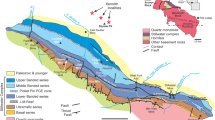Summary
Crystallographic intergrowths of jacobsite and hausmannite (“vredenburgite”) occur in association with braunite in the Precambrian Sausar Group of rocks, India, that were metamorphosed under 600-700°C and P ∼ 6 kb. Quartz, hematite, rhodochrosite and a later hausmannite may occasionally occur as minor associates. Detailed characterization of the intergrown phases reveals that hausmannite lamellae, oriented in 4 or 5 crystallographic directions in the jacobsite host, show a wide variation in thickness and tapered intersections at low angles. The lamellae may be locally deformed. Analytical data reveal that the composition of natural hausmannite and jacobsite in the intergrowths cannot be approximated within the system Fe3O4 -Mn3O4, as has been conventionally done. These really belong to the Fe2O3-Mn3O4 subsystem. In the two phase intergrowths, hausmannite is depleted and the jacobsite is enriched in Fe in higher grade rocks. Mineral associations and petrographic considerations suggest that the jacobsite-hausmannite intergrowth originated through prograde decarbonation-oxidation reactions of a carbonatic precursor in an unbuffered X CO2 situation, but f O2 was held between hematite-magnetite and bixbyite-hausmannite buffers at the ambient physical conditions of metamorphism. Subsequent oxidation yielded a strong oxygenbuffering assemblage jacobsite, hausmannite, braunite, hematite and quartz. This study negates the commonly held idea that hausmannite jacobsite crystallographic intergrowth (“vredenburgite”) originates through unmixing of a high ([ldvredenburgite”) originates through unmixing of a high temperature spinelss temperature spinelss during cooling.
Zusammenfassung
Kristallographische Verwachsungen von Jakobsit und Hausmannit („Vredenburgit”) treten in Verbindung mit Braunit in Gesteinen der präkambrischen Sausargruppe in Indien auf. Die Gesteine wurden bei Drucken von ca. 6 kbar und Termperaturen von 600–700°C metamorphosiert. Quarz, Hämatit, Rhodochrosit, und Hausmannit als Spätphase treten gelegentlich als untergeordnete Gemengteile auf. Hausmannit-Lamellen, die in vier oder fünf kristallographischen Richtungen in Jakobsit orientiert sind, haben sehr unterschiedliche Durchmesser und bilden versetzte Zwickel in kleinem Winkel mit dem Jakobsit. Die Lamellen können lokal deformiert sein. Analytische Daten zeigen, daß die Zusammensetzung von natürlichem Hausmannit und Jakobsit in Verwachsungen nicht, wie bisher angenommen, in dem System Fe3O4-Mn3O4 dargestellt werden kann. Diese Verwachsungen gehören vielmehr in das Fe2O3-Mn3O4 System. In höher-gradigen metamorphen Gesteinen ist Fe in zwei-phasigen Verwachsungen im Hausmannit ab- und im Jakobsit angereichert. Die Mineralzusammensetzung und petrographische Gesichtspunkte lassen darauf schließen, daß die Jakobsit/Hausmannit Verwachsung durch prograde Dekarbonatisierung/Oxydationsreaktion eines karbonatischen Vorläufers in einem nicht gepufferten X CO2 Milieu entstanden ist. F O2 wurde durch Hämatit-Magnetit und Bixbyit-Hausmannit Puffer unter den gegebenen physikalischen Bedingungen der Metamorphose stabil gehalten. Eine nachfolgende Oxydation führte zu einer starken Sauerstoff-puffernden Assoziation von Jakobsit, Hausmannit, Braunit, Hämatit und Quarz. Diese Untersuchungen widerlegen die allgemein verbreitete Ansicht, daß die kristallographische Verwachsung von Hausmannit und Jakobsit (Vredenburgit) durch Entmischung eines Hochtemperatur-Spinells während der Abkühlung entstanden ist.
Similar content being viewed by others
References
Bence A, Albee A (1968) Empirical correction factors for the electron microanalysis of silicates and oxides. J Geol 76: 382–403
Buddington AF, Lindsley DH (1964) Iron-titanium oxide minerals and synthetic equivalents. J Petrol 5: 310–357
Dasgupta S, Banerjee H, Majumdar N (1984) Contrasting trends of mineral reactions during progressive metamorphism in interbanded pelite-manganese oxide sequence, example from Precambrian Sausar Group, India. N Jb Min Abh 150: 95–102
Fermor LL (1909) The manganese ore deposits of India. Mem Geol Surv Ind 37: 610
Frenzel G (1980) The manganese ore minerals. In:Varentsov IM, Grasseley Gy (eds) Geology and geochemistry of manganese, vol I. Akademiai Kiado, pp 25–154
Frondel C, Klein C (1965) Exsolution in franklinite. Am Min 50: 1670–1680
Haggerty SE (1981) Oxidation of opaque mineral oxides in basalts. In: Reviews in mineralogy, vol 3. Min Soc Am Hg 1–100
Mason B (1943) Mineralogical aspects of the system FeO-Fe2O3-MnO-Mn2O3. Geol Foren Forh 65: 263
Mason B (1946) A zincian vredenburgite from Franklin, New Jersey. Geol Foren Forh 68: 51–55
—— (1947) Mineralogical aspects of the system Fe3O4 Mn3O4-ZnMn2O4-ZnFe2O4. Am Min 32: 426
Muan A, Somiya S (1962) The system iron oxide-manganese oxide in air. Am J Sci 260: 230–240
Nakamura Y, Kushiro I (1970) Compositional relations of coexisting orthopyroxene, pigeonite and augite in a tholeiitic andesite from Hakone volcano. Contrib Mineral Petrol 26: 265–275
Orcel J, Pavlovitch St (1931) Les caracteres microscopiques des oxydes de manganites naturels. Bull Soc Franc Miner Crist 54: 108–179
Ross M, Papike JJ, Shaw KW (1969) Exsolution textures in amphiboles as indicators of subsolidus thermal histories. Min Soc Amer Spec Pap 2: 275–299
Roy S (1966) Syngenetic Manganese formations of India. J. U. Press
—Roy S (1981) Manganese deposits. Academic Press, 458 pp
— (1986) Petrology of the manganese silicate-carbonate-oxide rock of Sausar Group, India. N Jb Min Mh 12: 561–568
Schneiderhohn H, Ramdohr P (1931) Lehrbuch der Erzmikroskopie, vol II. Berlin
Van Hook JJ, Keith ML (1958) The system Fe3O4-Mn3O4. Am Min 43: 69–83
Watanabe T, Kato A (1966) Ore microscopy and electron probe microanalysis of some manganese minerals with vredenburgite—type intergrowths. IMA Vol Min Soc Ind, pp 197–202
Author information
Authors and Affiliations
Additional information
With 1 figure
Rights and permissions
About this article
Cite this article
Dasgupta, S., Bhattacharya, P.K., Chattopadhyay, G. et al. Genetic reinterpretation of crystallographicintergrowths of jacobsite andhausmannite from natural assemblages. Mineralogy and Petrology 37, 109–116 (1987). https://doi.org/10.1007/BF01164186
Received:
Accepted:
Issue Date:
DOI: https://doi.org/10.1007/BF01164186




